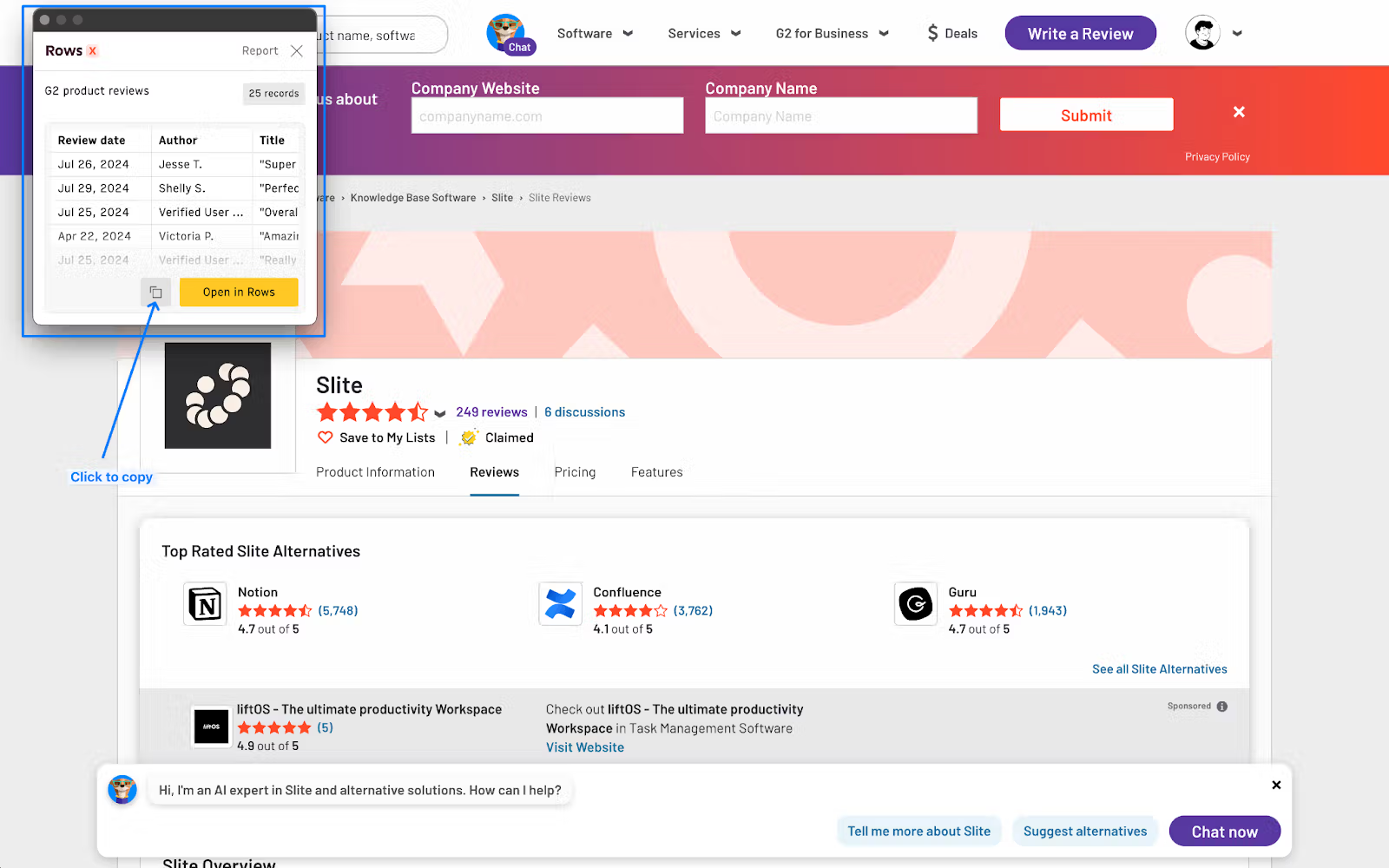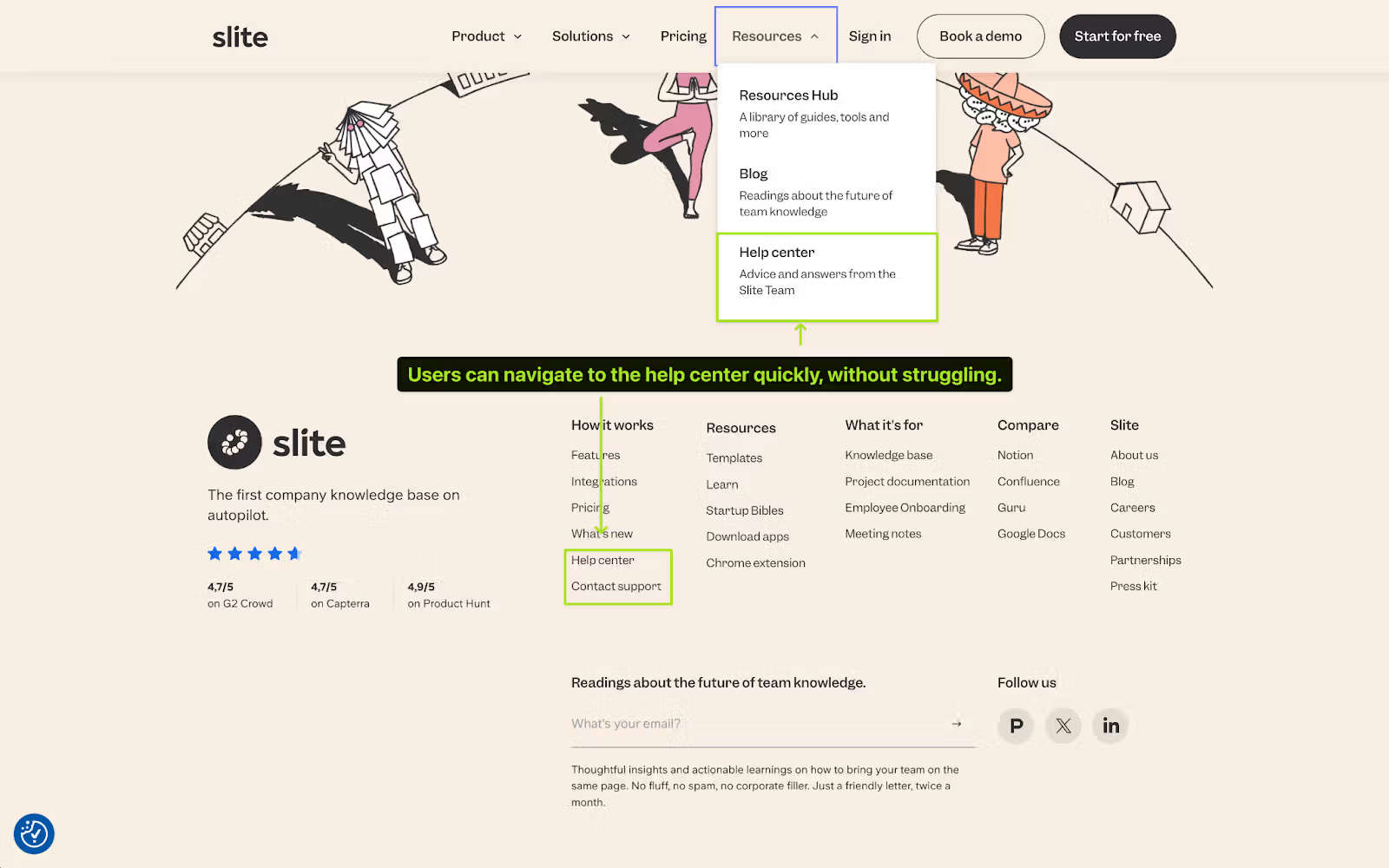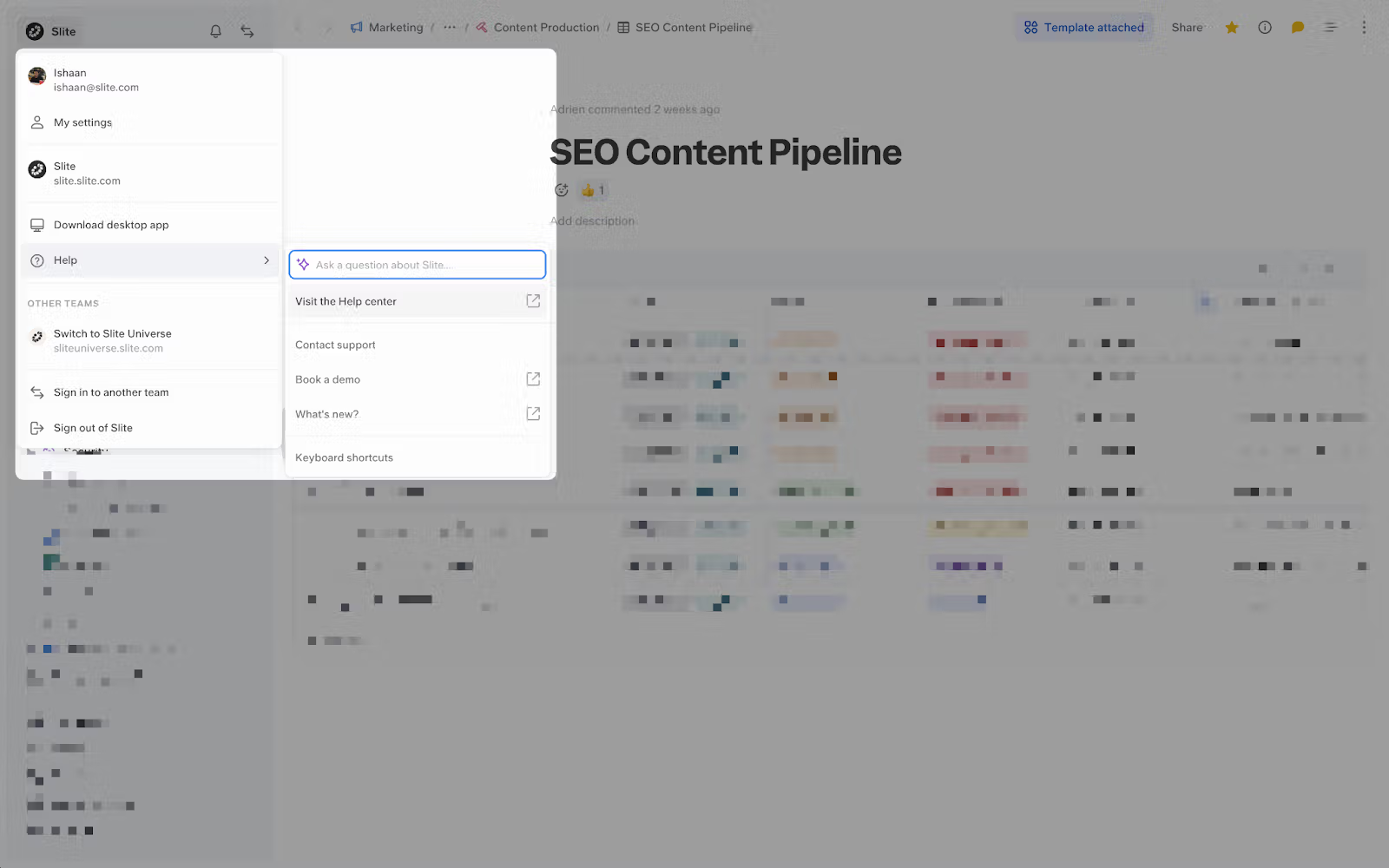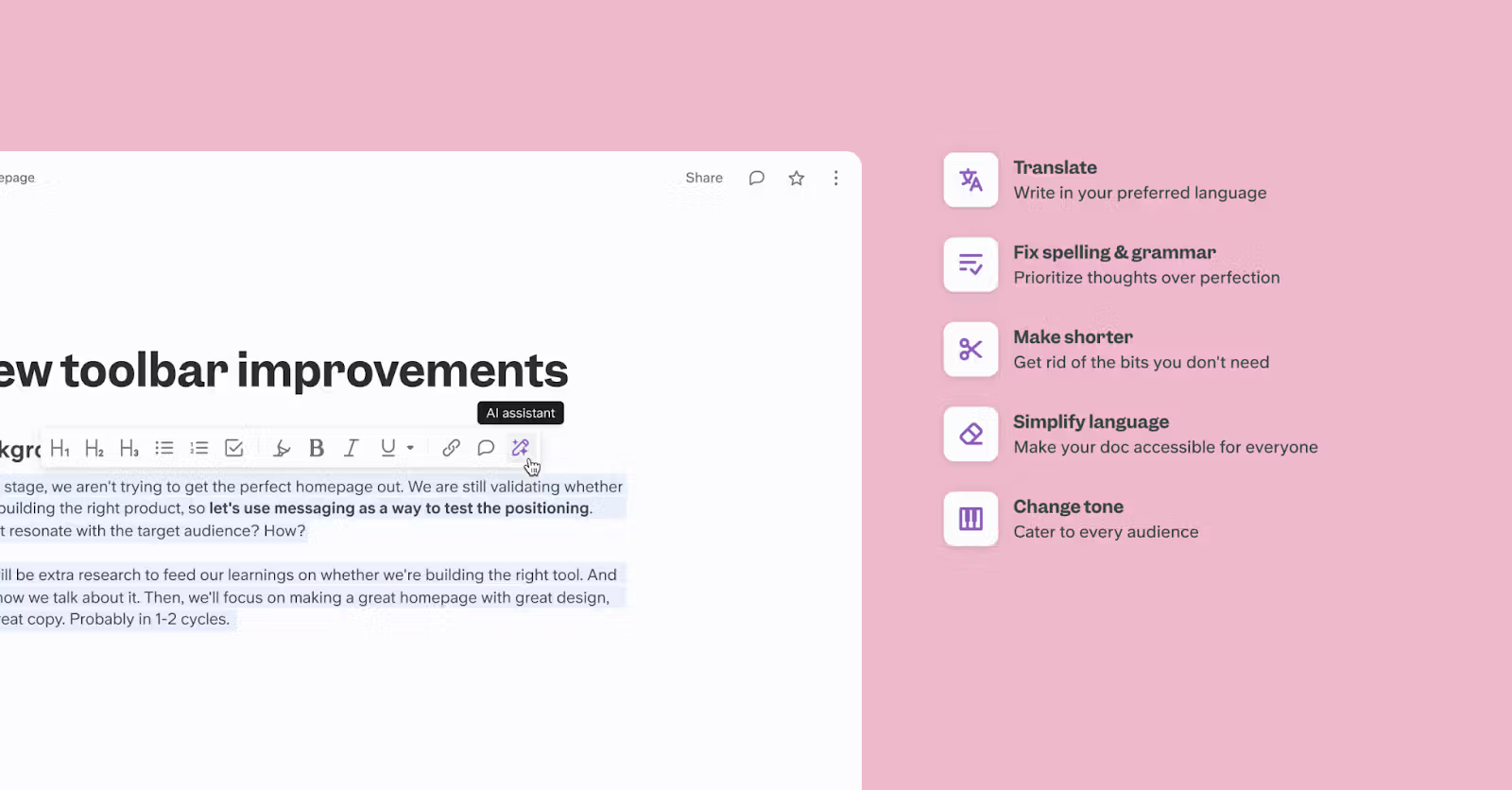Would you consult a chef to boil an egg? No, right?
We prefer to be as autonomous as possible, in life and work. It lets us move fast because we’re not waiting around for someone to revert back, especially for simple tasks/problems.
For business products, self-serve behaviour prevails even more. Information workers prefer to work with focus, avoid unnecessary interactions, and un-block their workflows as quickly as possible.
Rather than depending on an exec to circle back, they’d much rather look up a 2-min tutorial and self-implement, whenever possible.
Customer service knowledge bases help in exactly this by promoting customer self service. Anouk, Slite’s Head of Customer Success, shared:
It did help to decrease our tickets with about 20%.>
So, a Customer Service Knowledge Base improves productivity for both - your customer and your team.
Over time, many customers have asked us how to create a customer-facing Knowledge Base. So, we thought of documenting all our learnings in one definitive guide.
What is a customer service Knowledge Base?
A Customer Support Knowledge Base is a collection of how-to docs, designed for customers to find FAQs and resolve common issues, without having to contact support. A Customer Service Knowledge Base’s content types include FAQs, how-to guides, tutorials, videos, and other self-service resources.
For example, Slite’s Customer Service Knowledge Base looks like this:

Remember - a Customer Service Knowledge Base is different from your team’s standard Knowledge Base.
An internal Knowledge Base is built for a team’s daily internal usage, documentation, and discussions. A Customer Service Knowledge Base is built to help the customer help themselves.
What are the benefits of a Customer Service Knowledge Base?
For customers:
- Provides 24/7 self-service support
- Allows customers to get help quickly without contacting support
- Improves customer satisfaction
- Enhances the overall customer experience by empowering customers with easy access to information
For support teams:
- Reduces ticket volume so agents can focus on complex issues
- Speeds up ticket resolution times
- Provides a learning resource for agent onboarding and training
- Helps gather customer insights to improve products and services
- Enhances the customer service experience, leading to greater customer satisfaction and loyalty
For businesses:
- Lowers customer support costs
- Improves brand loyalty and retention
- Provides a scalable support solution
A step-by-step guide to Build a Customer Service Knowledge Base
There’s 2 ways to create your Customer Service Knowledge Base:
- Use Slite’s Wiki Generator
- Create it manually
Using knowledge base software can significantly enhance customer support by providing quick access to information for both staff and customers.
Step 1: Assign an owner
Get started by assigning an owner to your knowledge base. This can be a support leader, a technical writer, or even you. The owner will be in charge of:
- Building
Just be sure to put it in writing so your customer service team knows who to contact for changes/updates/requests.
Step 2: Make a list of customer pain points and FAQs
Your Customer Service Knowledge Base should clearly answer your customers’ most frequently encountered issues and questions, reducing the need for numerous customer service reps.
How do you find them?
- Talk to your customer-facing teams (sales and CS)
- Browse the internet to spot existing, unanswered questions
- Find covered topics from a direct competitor’s existing Customer Service Knowledge Base
Now, let’s go in detail about how to collect questions from all the above methods:
Ask your team
The typical way to collect questions is
- Go through your CRM
- Ask your sales team
- Ask your customer support team
- Ask your product team for product documentation
Since they look at different steps of the buyer's journey, they all might have different contributions.
These should be the first questions you need to nail in your Customer Service Knowledge Base.
Scrape customer questions from G2
If your company has a G2 profile and you're looking for inspiration from there, here's how:
- Add RowsX Chrome extension
- Go to your company's G2 profile.
- Click on the RowsX button. You should get a pop-up like this:

- Ask chatGPT “Identify the most burning questions customers will have about the product/service based on their G2 reviews here:”
- Voila, you have a list of questions based on your customer’s real thoughts about your product
Note: RowsX extension will only scrape the reviews on the first page. If you have multiple pages of reviews, go to each page and copy the data one page at a time in a spreadsheet.
The method works on sites like Capterra, Gartner, etc. as well. Feel free to replicate the process for each review site.
Scrape customer questions from social media
- Go to your comments and DMs. Manually copy all the customer questions you've received to a doc.
- Make a post asking your customers the questions they have about how-to's and tutorials. Invite comments.
- Send an email blast about the same to your existing customers. Send 1-2 follow-up emails to maximise the # of responses.
Scrape customer questions from your competitor
If you’re competing in an existing category, it's likely your competitor has already created their customer service content. You can use it as a direct inspiration for yours and find even more topics.
Here's how:
- Download Screaming Frog SEO Spider. It's a free technical SEO tool to get a website's sitemap and all URLs.
- Add the link in the box and hit Start. For this example, we'll use https://knowledge.hubspot.com/
- Once the crawl is complete, you'll have details of all their articles. Head to the Title column.
- Go through all their content titles, find which ones you'll need for your knowledge base as well.
All done - feel free to crawl as many similar knowledge bases as you need.
Step 4: Create an outline structure
Now that you’ve got a decent question base, you have to structure it for:
- Easy customer navigation
- Future scalability
Structuring a Customer Service Knowledge Base is a complex task.
But with Slite's free Wiki Generator, you can do so in a couple minutes, at most.
Go to Slite’s Wiki Generator and tell it to
“create a Customer Service Knowledge Base for my [company name] that does [product/service description]”
You’ll be redirected to the screen shown below.

Slite’s Wiki Generator creates your wiki in real-time on the right side.
In this page, you can direct AI using further prompts to
- Add specific sections
- Add/remove subdocs from a section
- Get advice on improvements
- Click on “Continue in Slite” to get access to your directory.
Remember to keep optimising it until your structure covers all customer questions you collected from previous steps.
Step 5: Produce initial Knowledge Base articles
Great, you’ve structured your customer questions. Now, you have to create a knowledge base article for all the questions.
How do you do it easily? There’s 3 methods:
- Find existing content that matches question intent
- This helps in maintaining consistency across your knowledge base articles.
- Leverage Slite to create article content from existing company information
- Create new content
Let’s look at each method in detail:
Find existing content that matches question intent
Why reinvent the wheel? You might already have content that answers some of your customers' questions. Here's how to find it:
- Search your company blog for relevant posts
- Check internal documentation or training materials
- Look through email responses your support team has sent
- Review product documentation or user manuals
Pro tip: Don't just copy-paste. Adapt the content to fit your Knowledge Base's tone and format.
Leverage Slite to create article content from existing company information
Slite's AI can help you generate article content based on your existing company information. Here's how:
- Gather relevant documents, presentations, or guides
- Use Slite's AI feature to summarize or expand on this information
- Prompt the AI with specific questions from your outline
- Review and edit the AI-generated content for accuracy and tone
Remember: AI is a tool, not a replacement for human expertise. Always fact-check and refine the output.
Create new content
For questions without existing answers, you'll need to create fresh content. Here's a quick process:
- Start with a clear outline for each article
- Write a draft, focusing on clarity and conciseness
- Include step-by-step instructions where applicable
- Add screenshots or videos for complex procedures. To learn more: read how to use videos in your Knowledge Base.
- Have a subject matter expert review for accuracy
- Edit for readability and consistent style.
If you’d like to fasten the document creation process, you can use Slite’s Free Magic Document Formatter. The tool converts long paragraphs and hard-to-read text into clean, structured, and formatted docs:

By combining these methods, you can quickly populate your Customer Service Knowledge Base with valuable content. Remember, the goal is to ship your customer-facing documentation fast. You can always keep improving the content later.
Step 6: Launch and promote your knowledge base
Publish your content online in a way that Google can index your articles. Also, update the sitemap and schema before submitting your website for a crawl request. Once that’s done, set up GA4 in case you’d like to see usage analytics of your knowledge base.
Once done, promote it internally and externally to customers.
How to externally promote your new knowledge base?
- Create social media posts with the link to our knowledge base
- Send it as an email blast to your existing customers
- Add it in the header and footer of your website

4. Ensure all your articles are SEO-indexable 5. Add the link to your product’s sidebar/settings so users can quickly access it, without leaving your product. For instance, this is how I, a Slite user, can quickly head for the help centre, if needed.

6. Push a product pop-up to announce your new customer knowledge base to your existing users. This is done to ensure that your existing customers are aware of your new knowledge base, even if they’re not following you on socials or opening your newsletters. It’s a must-do, especially if you have low open rates.
Step 7: Iterate based on feedback
Survey customers and analyse how to use data to optimise your knowledge base. You'll get valuable tidbits that you can implement to your knowledge base. The best way to incorporate their feedback is to commit to monthly updating your knowledge base.
7 Best Practices for a customer service knowledge base
1. Write how your audience writes
The knowledge base content should use language your customers actually use:
- Use simple words your customers will understand
- Write in a conversational tone using contractions
- Address your reader directly as "you" and "your"
- Add bullet points to make info easier to digest (see what we did here?)
- Use tools like Hemingway App to analyse your text’s readability. For how-to content, aim for readability Grade 9 or below.

2. Keep branding consistent
Follow brand guidelines to ensure the knowledge base aligns with your overall branding and messaging. This reinforces brand recognition and trust.
- Use your brand colours, logo, and fonts
- Maintain your brand's tone and messaging
- Follow brand imagery and graphic guidelines
If you don’t have brand guidelines in place, collect them using our brand guidelines template.
3. Intuitive IA and navigation
Well-organised information architecture and navigation helps users find answers quickly.
- Organise articles into clear category sections
- Use descriptive headings and subheadings
- Include table of contents on long articles
- Link related articles together
4. Collect customer feedback
Get feedback through surveys and usage metrics. This identifies content gaps and improvement opportunities.
- Send surveys asking how to improve the knowledge base
- Support agents can provide valuable insights by sharing common customer inquiries and challenges they face.
- Provide rating buttons to vote on article helpfulness
- Analyse search queries to identify gaps
5. Update content regularly
Outdated or inaccurate content frustrates customers. Keep information comprehensive with regular refreshes.
- Review old articles quarterly for needed updates
- Archive or delete outdated content
- Interview reps to identify new FAQs
- Add articles when products or features change
Conclusion - You’re not done, yet.
Congratulations! You've just empowered your team and customers to be more independent.
But remember, your Customer Service Knowledge Base isn't a "set it and forget it" resource.
It's a living, breathing entity that needs regular care and feeding.
As your customer base grows globally, consider scaling techniques like localisation by translating your most crucial articles into different languages. This not only improves accessibility but also shows your commitment to serving diverse markets, potentially opening new growth opportunities.
All the best, we hope you build a great Customer Service Knowledge Base!
Make Your Knowledge Base Better with Slite
Want to create a Knowledge Base that’s easy to use and maintain? Slite can help.
Excellent customer service is crucial for enhancing customer satisfaction and loyalty, and a well-maintained knowledge base plays a key role in achieving this.

We’ve built a tool that’s simple enough for everyone to use, but powerful enough to handle all your documentation needs - whether it’s for your customers or your team.

Slite makes it easy to write, organise, and find information. Our AI helper can even give you a head start on writing articles.

Lots of companies, big and small, use Slite to keep their knowledge organized. Why not give it a try? You can start for free and see how it works for you. We think you’ll find that Slite makes managing information much easier for everyone in your company.
Ready to make your Knowledge Base better? Come and try Slite today. We’re here to help you get started.
